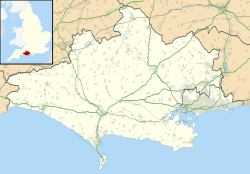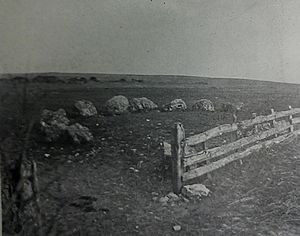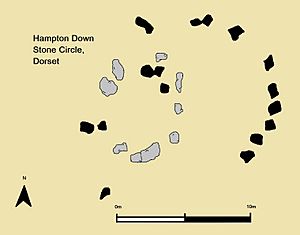Hampton Down Stone Circle facts for kids
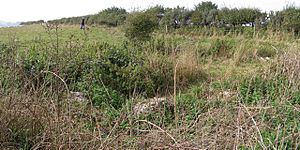
The circle, situated amid overgrown bracken, in 2006
|
|
| Region | Southwestern England |
|---|---|
| Coordinates | 50°40′36″N 2°34′23″W / 50.676750°N 2.573132°W |
| Type | Stone circle |
| History | |
| Periods | Neolithic / Bronze Age |
The Hampton Down Stone Circle is an ancient stone circle. It is found near the village of Portesham in Dorset, a county in south-western England. Experts who study old things, called archaeologists, think it was built during the Bronze Age. This was a time long ago when people used bronze tools.
Stone circles like this one were built across Britain, Ireland, and Brittany. This happened between 3,300 and 900 BCE. We don't know for sure why these circles were built. Archaeologists guess they might have been special religious places. Perhaps the stones had a magical meaning for the people who put them there. Some even think this site might not be a stone circle at all. It could be kerbstones from a round barrow, which is an ancient burial mound.
Many stone circles were built in the Dorset area. They were usually made from a type of rock called sarsen stone. These circles were often smaller than those found in other places. The Hampton Down circle was built on a high, open downland ridge. From here, people could see the coast.
Originally, this circle had eight or nine sarsen stones. It was about 20 feet (6.5 metres) wide. A path led to it from the north. Over time, the circle changed a lot. By 1908, it had moved east from its first spot. A hedge was built across it, and the number of stones grew to sixteen. By 1964, there were twenty-eight stones!
In 1965, an archaeologist named Geoffrey J. Wainwright led a dig. This excavation helped find the circle's original size and location. After the dig, the circle was rebuilt in its first place. The extra stones were removed.
Contents
Where is the Stone Circle?
The Hampton Down Stone Circle is located on a high, open downland ridge. It sits about 680 feet above sea level. You can find it about 1 kilometre (0.6 miles) north-west of Portesham. The land is private.
The circle is on the edge of Portesham Hill. It looks out over the coast. If there weren't so many plants back then, people would have had amazing views of the sea. This site is a scheduled monument. This means it has special legal protection.
Why Were Stone Circles Built?
Around 3000 BCE, people in southern and eastern England started building new types of monuments. They stopped making long burial mounds and other large earthworks. Instead, they began to build circular monuments. These included earthen henges, timber circles, and stone circles.
Stone circles are found in most parts of Britain where there are stones. They are very common in south-western Britain and north-eastern Scotland. People built these circles for a very long time, from 3300 to 900 BCE. Most of them were built between 3000 and 1,300 BCE.
These ancient stone circles often show little sign of people visiting them right after they were built. This suggests they might not have been used for noisy rituals. They may have been quiet, empty places. Some archaeologists think stone was linked to the dead. Others believe the stones might have represented gods or other powerful beings.
Dorset has only a few stone circles. There are nine possible examples. All but one are on the chalk hills west of Dorchester. The Dorset circles are usually small. None are wider than 28 metres (92 feet). They are also oval-shaped, though their original shape might have changed. Most are made of sarsen stone. This stone may have come from the Valley of Stones. This area is near Littlebredy, close to many of these circles.
Archaeologists Stuart and Cecily Piggott thought the Dorset circles were from the Bronze Age. Another archaeologist, Aubrey Burl, agreed. It's possible they were not all built at the same time. Their use might have continued into the Middle and Late Bronze Age. These circles are similar to those found on Dartmoor and Exmoor. They might also be connected to earthen henges built in Dorset around the same time.
What Does the Circle Look Like?
The Hampton Down Stone Circle has changed a lot over time. In 1908, a photo showed sixteen stones. By 1964, there were twenty-eight stones! In 1939, a hedge and a bank cut the circle in half. This separated three stones from the rest.
Later, people found that many stones had been moved to the site. These stones were found when a nearby field was cleared in 1964. It's possible these extra stones were once part of another ancient monument. This could have been a long barrow or round barrow nearby. All the stones are made of sarsen.
In 1939, the Piggotts thought ten stones in the eastern half of the circle were in their original spot. They said it was hard to tell if the stones were standing up or lying down. This was because of their rough, cube-like shapes. Based on these stones, they guessed the circle was originally about 35 feet (11–12 metres) wide.
The Dig: What Was Found?
In 1964, farming work disturbed the stones in the circle. So, in May 1965, a dig was ordered. Geoffrey J. Wainwright led this archaeological excavation. All 28 stones were moved using a crane. This allowed archaeologists to dig underneath them.
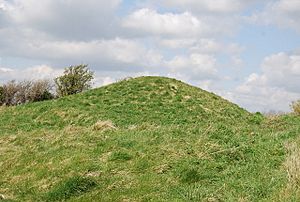
The dig showed that the stones were not in their original ancient place. The first circle was found a few feet to the west, under the hedge. This original circle had eight or possibly nine spots for stones. It was oval-shaped. The edge of the circle had V-shaped ditches on its east and west sides. The widest part of the circle was about 20 feet (6.5 metres). This was much smaller than what the Piggotts had thought.
A 4-foot (1.2 metre) wide path led to the circle from the north. Three small holes were found on the western side of the circle. This was where the path joined it.
If the Hampton Down circle was used for rituals, only a few people could stand inside it. Unlike some stone circles in northern Britain, no cremation remains were found here. Archaeologist Aubrey Burl suggested that the Hampton Down Stone Circle might not have been a stone circle at all. He thought the stones could have been the kerbstones of a round barrow. He pointed out that round barrows were known in Poole, about 20 miles (32 kilometres) east of the site.
The excavation did not find any objects. This means it was hard to figure out exactly when the site was built. Wainwright suggested it was from the Early Bronze Age. He based this on other dated circles in Britain. He believed the stones were moved from their original spot in the late 1600s. This likely happened because of farming.
After the dig, some stones were put back into their original spots. This created a copy of the first circle. A fence was then put around the circle. This was to stop people from disturbing it again. As of 2003, the Hampton Down circle was the only one of Dorset's circles to have been dug up by archaeologists.


